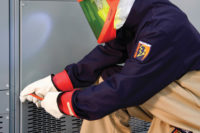
You and your staff know that OSHA requires the use of rubber insulating gloves when working in contact with more than 50 volts AC, and your employees regularly use their rubber insulating gloves. Where your arc flash hazard risk analysis identifies HRC (Hazard Risk Category) 2 or higher, you have compliant arc flash apparel, probably in kits containing rubber insulating gloves as well as the other required equipment. So everybody is safe, right?
Wrong! To stay compliant, the rubber insulating gloves need to periodically be electrically retested. OSHA makes this very clear in 1910.137(b)(2)(viii) which reads, in part, “Electrical protective equipment shall be subjected to periodic electrical tests. …the maximum intervals between tests shall be in accordance with … Table I-6.” Rubber insulating gloves are to be tested before the first issue and every six months thereafter. If the rubber gloves have been tested but not issued for service, they may not be placed into service unless they have been electrically tested within the previous 12 months. OSHA makes specific reference to the test method contained in ASTM F-496, “Standard Specification for In-Service Care of Insulating Gloves and Sleeves.”
Watch out for damage
Damage to many types of personal protective equipment (PPE) can be apparent when the equipment or devices are inspected by the user, but rubber electrical insulating products are more complicated. The reduction in effectiveness can be caused by a variety of factors that may not be readily apparent to the user. Rubber protective equipment, including gloves, can be damaged by abrasion, scratches, cuts and snags as well as sunlight and chemical exposure. All references to rubber insulating gloves can be extended to other rubber electrical insulating PPE including sleeves, blankets, line hose, covers and matting, although these items are not often applicable to industrial, nonutility and non-contractor situations.
A qualified electrical testing laboratory, following the guidelines in ASTM F-496 and ASTM F-1236, “Standard Guide for Visual Inspection of Electrical Protective Rubber Products,” can help ensure that your rubber gloves are safe and effective for their intended use. The process includes thoroughly cleaning your rubber gloves, visually inspecting them for physical damage, performing dielectric testing at the rated test voltage, and marking and packing the accepted products for return shipment.
Visually inspecting rubber gloves identifies physical, chemical or ozone damage. Direct light is recommended because it enhances the ability to see surface imperfections on the rubber. Inflating the gloves with air or otherwise stretching the surface highlights age and ozone damage as well as other physical damage. Although rubber insulating gloves are generally worn with leather protective cover gloves (arc flash kits include rubber gloves and leather gloves as a set), OSHA 1910.137(b) (2)(vii)(B) permits the use of rubber insulating gloves without leather protector gloves under certain circumstances. However, this often leads to more extensive physical damage to the rubber gloves.
After visual inspection, rubber gloves will be tested at their rated voltage using specialized equipment designed to gradually increase the voltage to the desired test level and measure the amount of prooftest current passing through the glove during the test cycle. The dielectric test is two-fold: pass/fail on the ability to withstand the rated test voltage and quantitative on the ability to prevent electric current passing through the glove above the maximum contained in the specifications. Products passing the inspection and test procedures can then be returned to service.
Be prepared
When preparing to work with and around electrical hazards, it is a good practice to have two pairs of rubber insulating gloves available — a pair and a spare. That way, if your primary pair does not look right when inspected before use or is at an electrical testing facility for the required periodic inspection and retest, you will have a good pair of gloves to use.
When not in use, rubber protective equipment must be stored properly and carefully. Avoid folding or creasing the rubber gloves and always dry wet gloves before storing. Leather protector gloves should be removed from the rubber gloves for storage as well. Because ozone can severely damage natural rubber products, do not store natural rubber gloves in sunlight or near electric motors or other ozone-producing equipment. Properly maintained, and periodically retested, rubber insulating products can provide years of protection.

